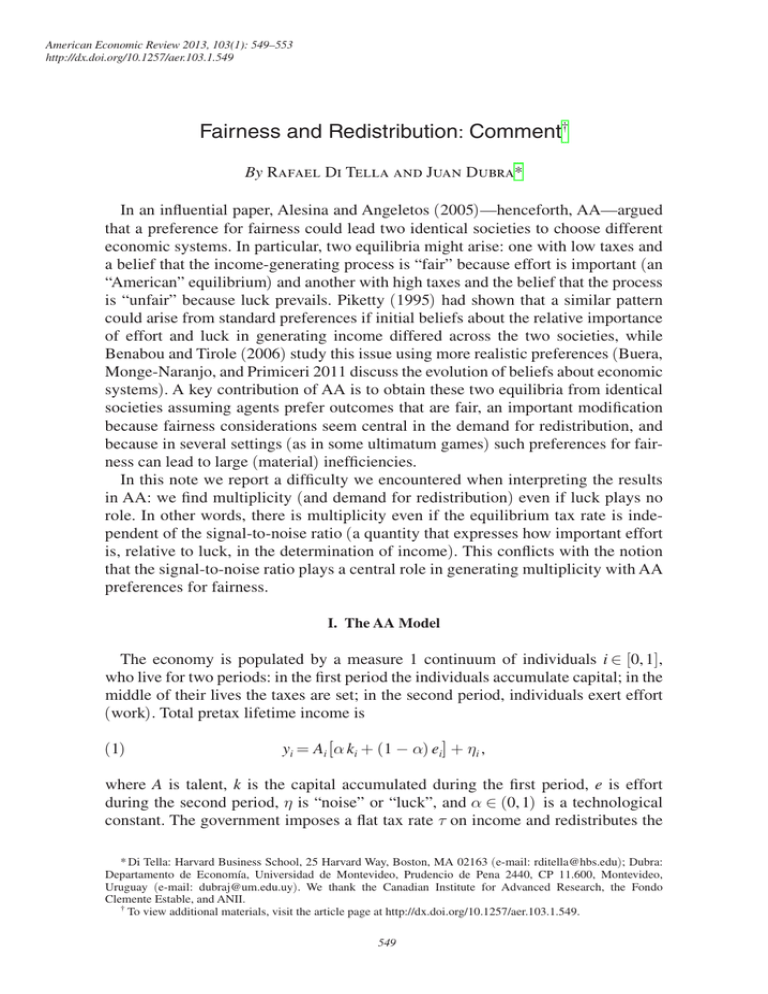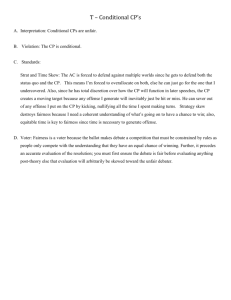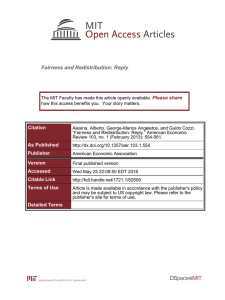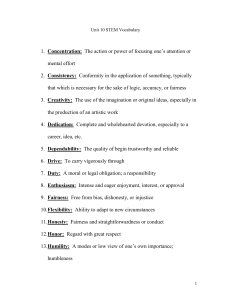Fairness and Redistribution: Comment
advertisement

American Economic Review 2013, 103(1): 549–553 http://dx.doi.org/10.1257/aer.103.1.549 Fairness and Redistribution: Comment† By Rafael Di Tella and Juan Dubra* In an influential paper, Alesina and Angeletos (2005)—henceforth, AA—argued that a preference for fairness could lead two identical societies to choose different economic systems. In particular, two equilibria might arise: one with low taxes and a belief that the income-generating process is “fair” because effort is important (an “American” equilibrium) and another with high taxes and the belief that the process is “unfair” because luck prevails. Piketty (1995) had shown that a similar pattern could arise from standard preferences if initial beliefs about the relative importance of effort and luck in generating income differed across the two societies, while Benabou and Tirole (2006) study this issue using more realistic preferences (Buera, Monge-Naranjo, and Primiceri 2011 discuss the evolution of beliefs about economic systems). A key contribution of AA is to obtain these two equilibria from identical societies assuming agents prefer outcomes that are fair, an important modification because fairness considerations seem central in the demand for redistribution, and because in several settings (as in some ultimatum games) such preferences for fairness can lead to large (material) inefficiencies. In this note we report a difficulty we encountered when interpreting the results in AA: we find multiplicity (and demand for redistribution) even if luck plays no role. In other words, there is multiplicity even if the equilibrium tax rate is independent of the signal-to-noise ratio (a quantity that expresses how important effort is, relative to luck, in the determination of income). This conflicts with the notion that the signal-to-noise ratio plays a central role in generating multiplicity with AA preferences for fairness. I. The AA Model The economy is populated by a measure 1 continuum of individuals i ∈ [0, 1], who live for two periods: in the first period the individuals accumulate capital; in the middle of their lives the taxes are set; in the second period, individuals exert effort (work). Total pretax lifetime income is (1)yi = Ai [α ki + (1 − α) ei] + ηi , where A is talent, k is the capital accumulated during the first period, e is effort during the second period, η is “noise” or “luck”, and α ∈ (0, 1) is a technological constant. The government imposes a flat tax rate τ on income and redistributes the * Di Tella: Harvard Business School, 25 Harvard Way, Boston, MA 02163 (e-mail: rditella@hbs.edu); Dubra: Departamento de Economía, Universidad de Montevideo, Prudencio de Pena 2440, CP 11.600, Montevideo, Uruguay (e-mail: dubraj@um.edu.uy). We thank the Canadian Institute for Advanced Research, the Fondo Clemente Estable, and ANII. † To view additional materials, visit the article page at http://dx.doi.org/10.1257/aer.103.1.549. 549 550 THE AMERICAN ECONOMIC REVIEW February 2013 proceeds in a lump sum fashion, so that the individual’s consumption is, for government transfer G = τ ∫i yi , ci = (1 − τ) yi + G. 1 [α k 2 + (1 − α) e 2 ], Individual preferences are, for u i = Vi (ci, ki, ei) = ci − _ i i 2 βi 1 Ui ≡ ui − γ Ω ≡ ci − _ [α k 2i + (1 − α) e 2i ] − γ Ω , 2 βi where ui is private utility from own consumption, investment and effort, β i is an impatience parameter, γ is “distaste for unfair outcomes,” and Ω is a measure of the social injustice in the economy. AA assume _that A, η, and β are i.i.d. across agents, We let δ be the mean of δ, and δ m its median; and that for δ = A2β, Cov(δ, η) = 0. _ _ is the mean of AA also assume Δ = δ − δm ≥ 0 and normalize δ m = 2. Similarly, η η and ηm its median. ui)2, where ui is the actual level AA define social injustice as Ω = ∫i (ui − i is a measure of the “fair” level of utility the individof private utility, and u ual should have (deserves) on the basis of his talent and effort. They define i, ki, ei) for i = Vi ( c u i = y i = Ai [α ki + (1 − α) ei]. (2) c The individual chooses k when taxes haven’t been set, so anticipating a tax rate of τe(which will be equal to the actual τ in equilibrium), he maximizes 1 (3) ui = (1 − τe ) Ai [α ki + (1 − α) ei] + (1 − τe ) ηi + G − _ [α k 2i + (1 − α) e 2i ] 2 βi with respect to k, and using the actual tax rate in equation (3) maximizes with respect to e to obtain (4) ki = (1 − τe ) Ai βi and ei = (1 − τ) Ai βi . Then, U i = ui − γ Ω implies δ _ Ui (τ, τe ) = _i (1 − α τ 2e − (1 − α) τ 2) + ηi + τ (η − ηi) 2 _ + τ ( δ − δi)[1 − α τe − τ (1 − α)] − γ ((1 − τ)2 σ 2η + τ 2 [1 − α τe − (1 − α) τ]2 σ 2δ ). VOL. 103 NO. 1 di tella and dubra: fairness and redistribution: comment 551 A. Example: Multiplicity without Luck AA say: The critical features of the model that generate equilibrium multiplicity are (a) that the optimal tax rate is decreasing in the signal-to-noise ratio and (b) that the equilibrium signal-to-noise ratio is in turn decreasing in the tax rate (p. 970). We now present an example with no noise, no luck, and therefore a constant noiseto-signal ratio, that multiple equilibria. _ still has _ 999 47 27 _ , α = _ , and σ 2η = 0. We first δ = 20 , η = ηm = 0, γ σ 2δ = _ Set δm = 2, 1,000 25 d Um (τe, τe ) h _ = 0 has three solutions for τ e ≈ 0.99308, τ me ≈ 0.8029, and note that d τ l τ e ≈ 0.2031. The existence of three roots in [0, 1] follows from Bolzano’s Theorem 9 9 _ 15 , _15 ) /d τ, d Um ( _ , /d τ) > 0 > (d U _ 12 , _12 ) /d τ, d Um (1, 1)/dτ). and (d Um ( _ m( 10 10 ) This means, in principle, but we will now check it, that given an expected tax rate of τ je for j = l, m, h, the tax rate that maximizes the utility of the voter with the median values of the shocks is τ je ; that is, there is multiplicity of equilibria, even though luck plays no role. We now check that given a tax rate of τ le the tax rate that maximizes the utility of the individual with the median values of the shocks is again τ = τ le (the cases of τ me and τ he are similar and omitted). First note that the optimal tax rates for 20,302 20,302 20,302 _ 20,302 < Um( 0, _ < Um( _ 100,000 , 100,000 ) , τ le are neither 0 nor 1, since Um ( 1, _ 100,000 ) 100,000 ) 20,302 l and continuity of Um(τ, τe ) in τe implies that for τ e close to _ we still have 100,000 Um( 1, τ le ) < Um(0, τ le ) < Um(τ le , τ le ) . Therefore, the tax τ ∈ [0, 1] that maximizes Um(τ, τ le ) must solve dU(τ, τ le ) /d τ = 0. We know that d U(τ le , τ le ) /d τ = 0 (by defini­ tion of τ le ) , so we only need to check that it is the global maximum among τ ∈ [0, 1] which is ensured by concavity in the domain: d 2 Um (τ, τ le ) /d ( τ 2 ) ≈ −1.296 × 10−5 τ 2 + 1.0331 × 10−2 τ − 1.3781 < 0 (for all τ ∈ [0, 1]). B. Discussion 2 y Note that with no luck in the model, σ 2η = 0, for τe = τ we obtain that for σ the variance of “fair” income (the signal in AA), Ω = τ 2σ 2y = σ 2δ τ 2(1 − τ)2, which is nonmonotonic in τ, while one might expect unfairness to increase with taxes.1 Hence, it is possible that the key insights in AA can be restored if other definitions of what is fair are used. For example, one alternative definition involves keeping taxes in the definition of fair consumption (in AA “fair” consumption involves no taxes and no luck).2 Alesina and Cozzi (2012) analyze multiplicity using another 1 Thus, a tax rate of τ = 1 also minimizes unfairness Ω, which seems counterintuitive since there is no luck in this economy. Moreover, one difficulty in evaluating the claim that the tax rate that minimizes Ω depends on the signal-to-noise ratio is that the signal also appears to depend on the tax. 2 Di Tella, Dubra, and MacCulloch (2010) take this approach (see also the comment by Angeletos 2010). Alesina, Cozzi, and Mantovan (2009) study the dynamic implications of both types of preferences and note that the definition of fairness in AA is not only about fairness, but reflects instead that individuals “tolerate inequality coming from innate ability and effort, but are averse to inequality arising from everything else, luck, and redistribution” (p. 5). 552 THE AMERICAN ECONOMIC REVIEW February 2013 approach where the AA preferences are normalized by average income. Another possibility would be to insist that the effort imputed in “fair” consumption takes into account that there are no taxes. In other words, it may be more reasonable to i in equation (2), are not modify AA so that the k i and ei used to substitute into y those associated to the case where taxes may be positive. Finally, one may also insist on preferences for fairness that are consistent with the empirical evidence. For example, Levine (1998) and Rotemberg (2008) demonstrate that preferences for “reciprocal altruism” are consistent with the available evidence from the ultimatum games, while Di Tella and Dubra (2010) show that they lead to multiplicity in an economy similar to that presented in AA. One difficulty for exploring these conjectures in the AA framework is that a counterexample to the main theorem can be produced because AA claim that the individual with the median values of the shocks is the median voter, but in general he is not. In the online Appendix we give an example where the equilibrium tax rate, the one preferred by the median voter, is not the one identified in AA. The tax rate identified as the equilibrium in AA would be defeated in voting by the one preferred by the median voter (which can be shown to be a Condorcet winner, even if the median voter theorem does not apply). This wedge between the prediction of the AA model and what would happen in that economy is relevant, since it is currently not known if in the AA model multiplicity can arise when the equilibrium tax rate is one that, when anticipated, maximizes the utility of the median _ voter (in one special case, when δ = δm , Di Tella, Dubra, and MacCulloch 2010 show how to analyze the AA model, establishing that the median voter’s preferred tax rate is a Condorcet winner. But this case is not very relevant empirically, since it implies mean income equal to median income, and does not allow for a MeltzerRichard effect.).3 In brief, we believe that the main point in AA, namely, that a preference for fairness can lead to multiple equilibria, is potentially valid but some aspects of the particular framework they propose need to be revised. References Alesina, Alberto, and George-Marios Angeletos. 2005. “Fairness and Redistribution.” American Eco- nomic Review 95 (4): 960–80. Alesina, Alberto, and Guido Cozzi. 2012. “Fairness and Redistribution: An Extension.” Unpublished. Alesina, Alberto, Guido Cozzi, and Noemi Mantovan. 2009. “The Evolution of Ideology, Fairness and Redistribution.” National Bureau of Economic Research Working Paper 15587. Angeletos, George-Marios. 2010. “Commentary.” In The Natural Resources Trap: Private Investment without Public Commitment, edited by William Hogan and Federico Sturzenegger, 155–60. Cambridge, MA: MIT Press. Benabou, Roland, and Jean Tirole. 2006. “Belief in a Just World and Redistributive Politics.” Quarterly Journal of Economics 121 (2): 699–746. Buera, Francisco J., Alexander Monge-Naranjo, and Giorgio Primiceri. 2011. “Learning the Wealth of Nations.” Econometrica 79 (1): 1–45. 3 If there were multiplicity in this case, a continuity argument would establish the existence of multiple equilibria _ _ _ even if δ > δm . But two questions would remain: the argument would > δm , and δ close enough _ not apply to any δ to δmmight not be enough to fit real data; once the assumption of δ = δmis dropped, we do not know whether the median voter’s preferred tax rate is still a Condorcet winner, and so the plausibility of such a tax rate arising as an equilibrium is reduced. VOL. 103 NO. 1 di tella and dubra: fairness and redistribution: comment 553 Di Tella, Rafael, and Juan Dubra. 2010. “A Note on Fairness and Redistribution.” Harvard Business School WP 11-059. Di Tella, Rafael, Juan Dubra, and Robert MacCulloch. 2010. “A Resource Belief Curse? Oil and Indi- vidualism.” In The Natural Resources Trap: Private Investment without Public Commitment, edited by William Hogan and Federico Sturzenegger, 119–54. Cambridge, MA: MIT Press. Levine, David K. 1998. “Modelling Altruism and Spitefulness in Experiments.” Review of Economic Dynamics 1 (3): 593–622. Piketty, Thomas. 1995. “Social Mobility and Redistributive Politics.” Quarterly Journal of Economics 110 (3): 551–84. Rotemberg, Julio J. 2008. “Minimally Acceptable Altruism and the Ultimatum Game.” Journal of Economic Behavior and Organization 66 (3–4): 457–76. This article has been cited by: 1. Alberto Alesina,, George-Marios Angeletos,, Guido Cozzi. 2013. Fairness and Redistribution: Reply. American Economic Review 103:1, 554-561. [Abstract] [View PDF article] [PDF with links]







